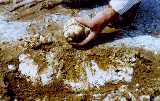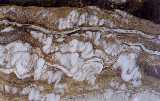
Locality 5
Landwards from shore face
The anhydrite nodules increase in both size and number landwards, forming interlocking sulfate polygons 0.3-1m in diameter up to 70 cm thick, with displacement and replacement causing the original sediment to be confined to partings between anhydrite nodules in the form of stringers (Reading, 1996).

Source http://www.soton.ac.uk/~imw/sabkha.htm
Photograph of anhydrite nodules at Duhhan sabkha Quatar
Most of this mosaic of anhydrite, however, has probably replaced earlier formed gypsum crystals, but because of sediment flowage and the replacive anhydrite, pseudomorphs after the original gypsum crystals are uncommon.
The nodular texture produced is refered to as chicken-wire anhydrite and this is the typical texture of many ancient sulfate deposits. Anhydrite is also precipitated as thin beds or layers of caoleced nodules in the more landward parts of the sabkhas. These beds are commonly irregularly contorted and buckled, forming the so-called entrolithic texture, also common in ancient sulfates (Tucker, 1991).

Source http://www.soton.ac.uk/~imw/sabkha.htm
Photograph of enterolithic in secondary gypsum
The formation of anhydrite requires an arid climate with high mean annual temperature above 22 degrees C and with seasonal temperatures in excess of 35 degrees C. Where the climate is less arid, then primary nodules of gypsum crystals may develop within the sediment. This is happening in sabkhas along the Mediterranean coast of Egypt.
 |
Diagram adapted from, Tucker (1991). |
Primary textures exhibited by anhydrite in both modern and ancient nodular deposits include fine equant mosaics and felted and parallel-subparallel arrangements of laths. Recrystallization of equant and lath anhydrite may take place to produce coarse, granular mosaics, large, fibrous crystals and fibro-radiating aggregates (Tucker, 1991).
This page was created by Pamela Williams
Last Modified:18/06/02